By Marshall Buck
A review of 1:18 scale Maserati 300S models from CMC, and thanks to Walter Bäumer’s great (big) book for helping in research on these racers.
From 1955 through 1958, Maserati produced a total of twenty-six of the wonderfully balanced 300S sports racers. Sir Stirling Moss once wrote that the 300S was “…..one of the easiest, nicest, best balanced sports-racing cars ever made….” and he should certainly know. I’ll add my two cents worth…… it was, and is still one of the prettiest as well. Within the entire production there were three notable body styles, each featuring numerous detail differences.
1- First series cars, short nose, and shortest body.
2- Interim series, semi-long nose, with a slightly longer rear. Fewest cars made with this body.
3- Long nose, and long rear end.
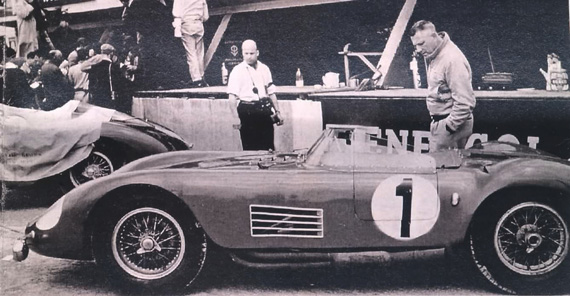
S/n 3066 at Le Mans in 1956. Note the lack of a running light at the lower right corner of the number circle.
CMC Classic Model Cars is one of the most well-known makers of highly detailed mass produced collector models; they have just raised the detail bar three more notches (one notch for each of the models presented here) with their 1:18th scale Maserati 300S replicas. Stunning, marvelous, and spectacular are words that aptly apply to these miniatures. At least one, or even all three, are pieces most collectors will desperately want, regardless of the fact that the particular car chosen to replicate was not necessarily the ideal 300S to model. The specific 300S CMC chose to model is an interim series car, Ch. No. 3056 which originally started life as 3066, and though 3066/3056 has an extensive racing history, it is filled with many DNF’s and no wins.

My favorite view of the restored version, which shows attention to some of the subtle details such as headlight covers with three hold down pins, and the trident in the grill opening.
This Maserati was repaired and upgraded by the factory, and on one factory visit in mid-1958, it received the engine from 3056, hence the official chassis number change. The “first” 3056 was also officially renumbered to 3077. The whereabouts of both chassis and engine of 3066 are currently unknown. To confuse you a bit more; The “road” version shown should be considered 3056 as restored around 1989/90, and has been since. The Le Mans 1958 version is of the same car, but as 3066, and the rolling chassis is that of 3056, which is mainly due to the exhaust pipe, and Dunlop tires it is fitted with. Got it?
I also would have preferred if CMC had chosen a more recognizable earlier or later 300S, as well as one with a more successful race record than 3066/3056 has, but as is often the case, there are influencing factors behind the scenes with model production. In this instance, 3066/3056 happened to be located very near the German offices of CMC making it very easy to travel to, and the now former owner was very cooperative granting CMC’s engineers full access to the car……So ends the mystery of why this car. With that said, I still would have chosen a different 300S, I am happy, and thankful to see a superb model of any Maserati 300S.
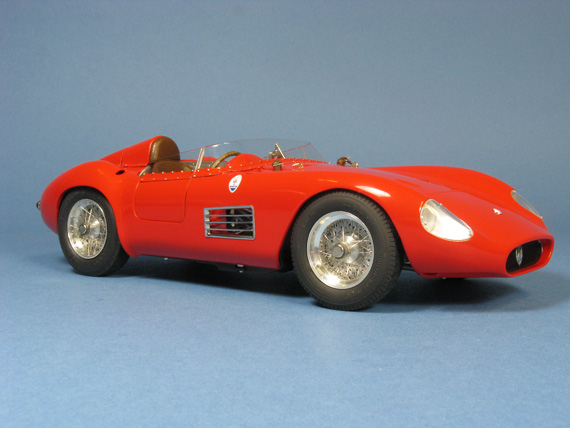
Stance of the model is about as good as it gets, and nice to be able to see various details behind the chrome side vent.
I’ll start with the restored “road” version since that was CMC’s first 300S release (followed by the Le Mans car, and then rolling chassis). As mentioned, the model, replicates the car as it was restored a little over 20 years ago. There is no other 300S that looks quite like this car; which is the result of combing the various works added details and upgrades along with the interim style that only a few of these cars carried, and then the later restoration with added headrest fairing which it never had prior to restoration…… That goes to show, that when you’re the one writing the checks, you can have whatever you want, no matter what anyone else may think.
This model has a commanding presence however it is displayed, especially with the front and rear deck lids removed. The flowing body of 3056 is perfectly captured, and covered in an excellent Pebble Beach Concours type of high gloss hand rubbed paint finish. This jewel is made up of a staggering number of parts, 1,838 in total. There is so much going on that it is difficult to focus on one area at a time.
As with all models from CMC, their 300S features a completely detailed and mostly hidden chassis. Framework, suspension, all components, hoses, cables, clamps and the list goes on. The attention to detail is impressive; look closely (with a magnifier) at the knock-off wheel spinners and the central Borrani hand logo and text are there in 3D – stamped or engraved!

Even with what you can see in this view of the restored version underside, it shows why you really need to have the rolling chassis to go with it.
Undo anyone of those knock-offs, remove one of the beautifully made wire wheels shod with excellent miniature Dunlop tires, and you’re treated to gorgeous finned brake drums. Now; as superb as the wire wheels are, they should be painted silver, but are not. CMC also made a slight mistake in replicating 3056 as restored in that the rear wheels are the style this car originally raced on in the 1950’s….. and correct for the Le Mans version, but not for what is on the restored car.
Up top again, the doors pivot smoothly on U shaped hinges and are held closed by little button latches that gently and precisely click. The fender mounted vent in front of the driver opens as well, take care with this part. The interior is a joy to behold with a detailed dash and those well-known blue face gauges. Seats are covered in leather. The mirror and multi-piece bracket atop the dash will tempt you to touch and try to adjust it, but don’t; this is a static part. Most all finishes have been well replicated, except for the bare metal floors showing off a highly reflective mirror-like finish…. hmm.
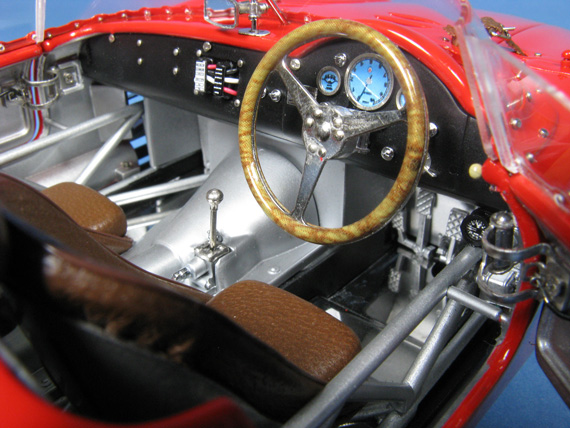
The busy cockpit is visually made more so by the incorrect mirror like metal floors which reflect everything. You get a glimpse of the leather trimmed seats which also have hold down parts attached to their backsides. Wonderfully detailed dash complimented by 3-spoke steering wheel with simulated wood rim. The very convincing wood pattern is actually printed on the two styrene rim pieces that sandwich the spokes.
Removable front & rear deck lids are held in place via leather straps & buckles along with delicate functional latches that pivot with working springs. It may take a while to get up the nerve to undo them, but if you do….. Wow. Overall an exciting engine bay is unveiled, just terrific, though I do have a quibble. There is some colorful wiring that I can’t quite place or recall ever seeing on any 300S including 3056.
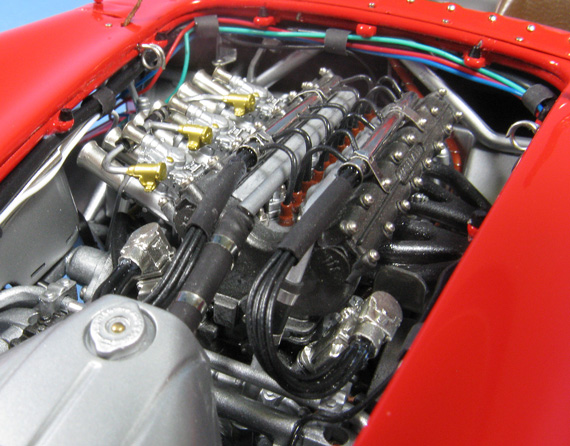
Not only the heart of the real car, but also the heart of the model. Love that cast radiator cap with wording in place. Practically every one of the hundreds of parts in this area are well fitted, but that green, red, and blue wiring is an odd slip.
However, the perfect valve covers with 16 separate bolts each, and the 12 spark plugs with boots & wires make up for those missteps. Strapped in place behind the cockpit, and above the rear framework, transaxle, and central leaf spring is the spare tire. Just aft of that is a beautiful fuel tank with opening cap, and to its left is the oil tank, also with an opening cap.
Back on the subject of the straps, buckles and latches. They are all very delicate parts, so I would not recommend trying to work any of them much at all. I leave mine undone. Overall, truly a wonderful and most impressive model. Reasonably priced at $454.
Maserati 300S Le Mans 1958, Ch, No. 3066
The 1955 race season was a year of debugging these cars, but in 1956…. Maserati came on strong, racking up numerous overall wins including the Nurburgring 1000 Kms with their well sorted 300S racers. They almost won the World Sportscar Championship title that year, only to lose out to Ferrari by a very small margin. There is no denying that any 300S is a great all around sports racing car.
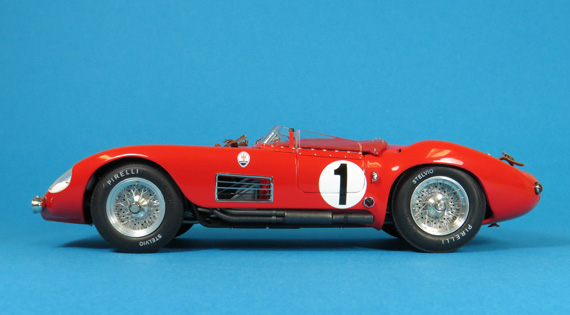
Profile shows overall shape well, and noticeably different Le Mans exhaust pipe almost exact, but should sweep up more at its end – and then there are those mistakenly added pesky round red sidelights.
This Le Mans race version is an exceptionally stunning model, and replicates Ch. No. 3066 as raced at Le Mans 1958, though it was a DNF. Most of my comments on the model of the restored “road” version apply to this Le Mans car, but with additional information and noted differences here. The LM car is also a ‘limited edition’ of 3,000 pieces, but I’d call that more of a limited production run.
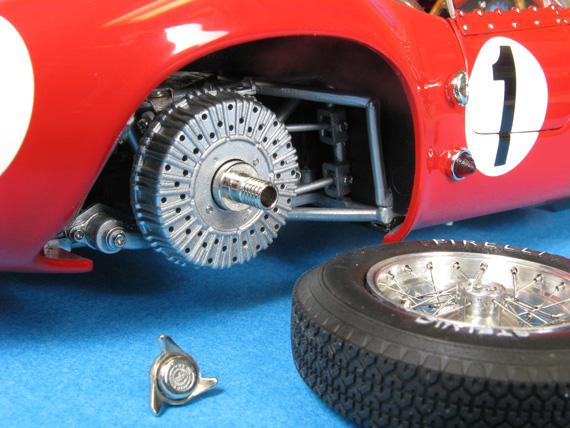
Beautifully detailed brake drum, and suspension. Notice that fantastic knock-off spinner with stamped in Borrani logo. Materials here are quite a combination: diecast metal, styrene, aluminum, and stainless steel.
Overall CMC have really nailed it, producing an extremely accurate model with few mistakes. They have nearly perfected the art of excellent fit and finish for mass produced diecast models, and this one does not disappoint. The overall level is superb, though two of the velocity stacks were slightly askew on my sample, which is not typical of what most collectors will receive. The oh-so smooth glass like hand rubbed paint finish shows off perfectly under any light, more appropriate for Pebble Beach than the race track.
As with the restored “road” version; to fully appreciate all this model offers, you really need to set aside a block of time to thoroughly examine it.
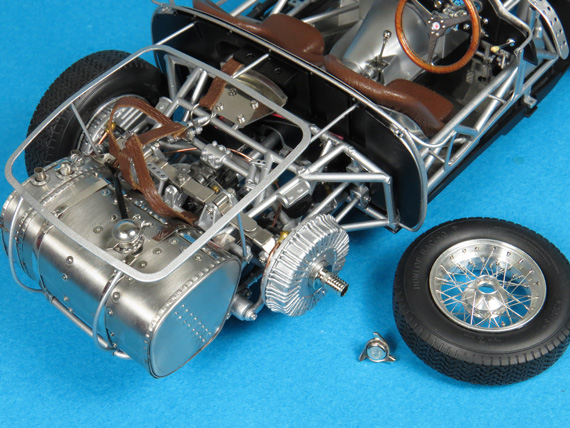
One of the more impressive chassis views, but really has to be seen in person to appreciate and take in the wealth of the deeply hidden detail. Yes, the suspension is made up of too many parts to count! Note the complete differences in tire tread and side walls from the Le Mans version. This is a photo of the chassis only version of the CMC model.
Differing from the restored version, gone is the head rest fairing; added is a convincing removable red leather tonneau cover, which has perfectly placed, perfectly fitting little tonneau snaps. Our Le Mans car rides on Pirelli Stelvio tires, modeled in two slightly different sizes with correct markings on their sidewalls; front 6.00 – 16, rear 6.50 x 16. The left side exhaust pipe is a beauty, and correct for this car at LM, it differs completely from the one on the restored version. The added front outboard mounted lights and brackets are also beautifully executed.
In the department of quibbles….. This model has the same “curious” engine bay wiring, and the mirror-like cockpit floor finish. But the biggee is that it has two round red I.D. Lights near each door that were never on this car at Le Mans. I’d say that’s a bit of an oops. We can mostly thank Maserati S.p.A. for that mistake, they provided the wrong information to CMC. Yes, more research should have been done, but this is what happens sometimes. I too, have had experiences with some of the self-proclaimed experts providing me with wrong information; hence it always pays to double and triple check everything.*
Even with my quibbles, the Le Mans version is hard to fault, and some may think I’m just impossible to please (really I’m not) but my biggest complaint goes back to the choice of particular car…..Ch. No. 3066 never won a race, and in its one LM run it was a DNF. Not to beat a dead horse, but – Oh hell I will anyway – I still find it difficult to accept why this car was chosen over other 300S Maseratis with better race records i.e. any race winning car as well as one that would have had the more recognizable and plentiful early or later series body. However……here it comes….. Defying my preferences, this piece is truly one of my very favorite 1:18 scale models of any car, and if you only buy just one currently available 1:18 scale model of a vintage racing car, then buy this one. It’s that great. Priced at $499.
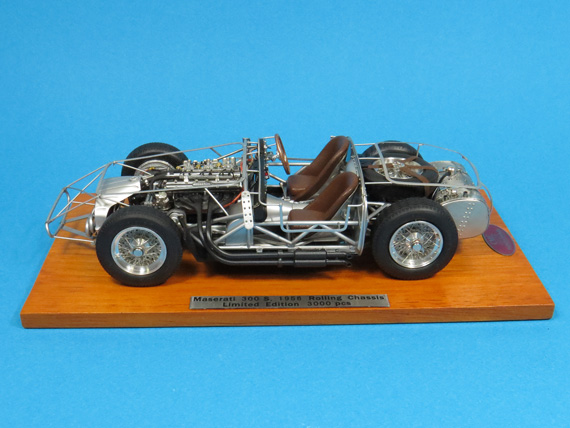
The chassis is quite a feat of model engineering, and considering the work involved it is a bargain. Framework is as you’d expect - made up of numerous individual metal pieces. The chassis comes with a well finished wood base; engraved plaque as well as CMC emblem/plaque are mounted to the base.
Want a little more detail? Then you can also purchase a separate model of the rolling chassis of 3056. What can I say? It is a stunner. Here you get the opportunity to view all the hidden details, plus the framework, and with nary a worry about handling or damaging any panels, hinges or latches. The open chassis also allows you to more easily unhook the three leather straps holding the spare in place. Once that wheel is removed….. My oh my, you get an eyeful of the rear suspension, transaxle, and more. Like the Le Mans version, the Rolling Chassis is a ‘limited edition’ run of 3,000 pieces, but priced at $356.
Oh yes, one more thing….. CMC is also producing an open ended run of more eye candy….. The 300S engine mounted in an attractive wood and acrylic display case. Priced at $147.
*Clarification regarding the incorrect – mistakenly added round red side lights on the Le Mans version. The research was done by CMC, not Maserati, and then it was further complicated by their miscommunication with Maserati about the lights, which lead to this rather big mistake.
All models shown are available directly from:
CMC Classic Model Cars.
1225 Jefferson Rd. Suite 14, Rochester, New York 14623
Phone: 585-292-7280
www.cmcmodelcarsusa.com


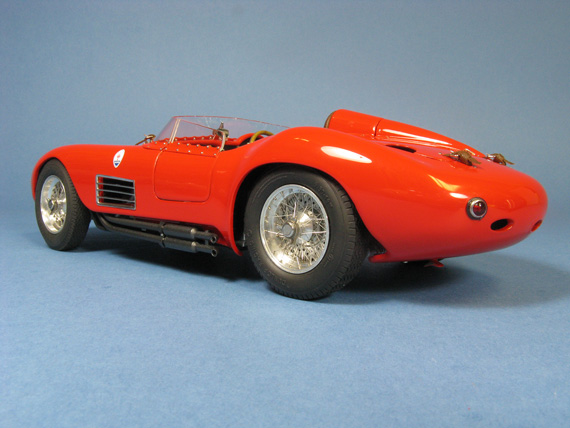
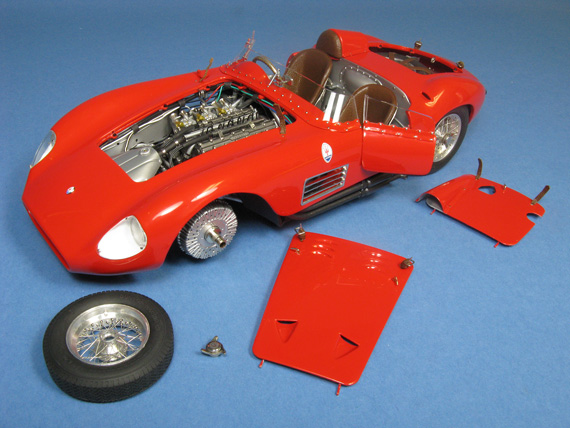
Maserati 300 S..my favorite sports racer..so clean and pretty
to My eyes, more attractive then the ” other” Modena Marque
Moss and Behra could do magic in one!
Is there any particular reason why no one ( except Profil 24, & that’s a “kit”) has not made a 1:18 Maserati 450S ?
I would really like to see a “good” 1970’s era Maserati Ghibli. The one that’s out there is….well……
I would really love to see a high quality Maserati 450S & a 1970’s era Ghibli.